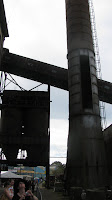I saw the Great Gatsby this afternoon. It's loyal to the words of F Scott Fitzgerald's novel (which I only read the previous week), although the glitz and the glamour and the imaging were definitely Baz Luhrmann and Catherine Martins'. The acting seemed fine, with Leonardo playing the larger than life Gatsby, and Cathy Mulligan playing a very beautfil Daisy. Neither quite convinced me, probably because Leonard is even bigger than his character (which is hard to imagine), and Mulligan gets the beauty right, but doesn't quite seem the innocent/manipulative character in the novel. Joel Edgerton as Tom is great, and Tobey Maguire is the everyman character, in the style of Jimmy Steward crossed with Peter Parker.
The cinematography is fabulous. It may have been filmed in NSW, but you wouldn't know from the pictures (although the huge number of Australian Actors gives it away, especially when Jack Thompson appears in an opening scence). It's beautifully filmed, and the parties at Gatsby's are beyond anything I could have imagined.
While I enjoyed the showier parts of the movie, I thought it was only a story about that. There doesn't seem to be a strong moral in this, just a sad ending. There doesn't seem to be a judgement on flashier times, because in a way, it's too beautifully presented and celebrated. Nick's character is neglected, and Miss Baker may as well not be in the movie, while Myrtle is purely a token part.
Gatsby claims near the end that he built the mansion for Daisy out of his imaginings. Which is what Baz Lurhmann has done for us. While Gatsby failed to impress Daisy, Lurhmann succeeds in impressing us.
The cinematography is fabulous. It may have been filmed in NSW, but you wouldn't know from the pictures (although the huge number of Australian Actors gives it away, especially when Jack Thompson appears in an opening scence). It's beautifully filmed, and the parties at Gatsby's are beyond anything I could have imagined.
While I enjoyed the showier parts of the movie, I thought it was only a story about that. There doesn't seem to be a strong moral in this, just a sad ending. There doesn't seem to be a judgement on flashier times, because in a way, it's too beautifully presented and celebrated. Nick's character is neglected, and Miss Baker may as well not be in the movie, while Myrtle is purely a token part.
Gatsby claims near the end that he built the mansion for Daisy out of his imaginings. Which is what Baz Lurhmann has done for us. While Gatsby failed to impress Daisy, Lurhmann succeeds in impressing us.





